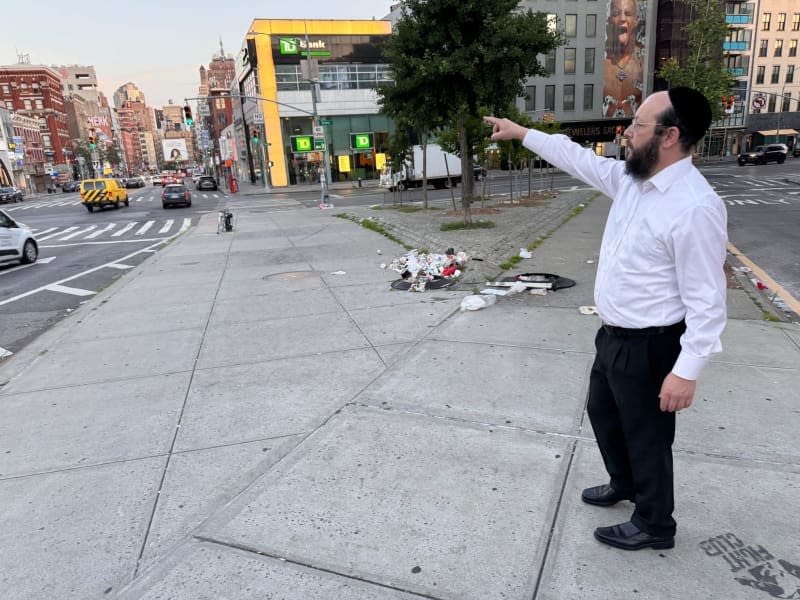The sun has not yet risen over the East River as Moshe Tauber steers his slightly dented black minibus across the George Washington Bridge to Manhattan in New York City.
On Riverside Drive, at the corner of 145th Street, he picks up the nylon line punctually at half past four – as he has done every Thursday for around 25 years.
He has not missed a single Thursday. “Do you see that fishing line up there? It goes all the way from 145th Street to Madison Avenue. We have to check that now, so that’s where we’ll start.” That distance spans about 13 kilometres.
Tauber is the father of 12 children, runs a nursery with his wife and teaches as a rabbi at a Jewish school.
But every Thursday, the 50-year-old makes the hour-long drive from his hometown of Monsey to New York City to inspect Manhattan’s eruv — a thin thread strung along street posts that encloses large parts of the borough.
The eruv allows observant Jews to do activities in public spaces which are normally forbidden on the Sabbath.
On Friday morning, Tauber comes back to meet with craftsmen and coordinate repairs – and to make sure that everything is ready for Friday evening.
A string that makes life easier on the Sabbath
“On the Jewish Sabbath – that is, from Friday sunset until Saturday nightfall – there are certain things that are not allowed,” says Adam Mintz, who works as a rabbi in Manhattan.
“One such thing is carrying objects outside of one’s own home – this also includes, for example, pushing a stroller or playing baseball,” he says.
“That’s why, almost 2,000 years ago, rabbis came up with the idea of marking out an area that is then no longer public space, but private. Then everything is allowed there again,” says Mintz.
Originally – in Roman times – real walls were built for this purpose. “But at some point that was no longer practical, so now we use ropes and posts.”
Cities worldwide have sacred perimeters
Nowadays, cities worldwide with sizeable communities of observant Jews have their own symbolic enclosures – including Antwerp, London, Toronto and Vienna.
New York City, where more than 1 million Jews are estimated to live, has several eruvim in different neighbourhoods.
But the eruv in Manhattan, which Moshe Tauber inspects in his minibus every Thursday, is the largest in the world, according to Rabbi Mintz. It encompassing almost the entire island, he says.
It is not only marked by stretched fishing line, it also includes fences or walls that have already been erected for other purposes.
Since the eruv in Manhattan was established in 1999, in consultation with the New York City government, Rabbi Mintz has been officially its president on behalf of about a dozen Jewish institutions and organizations – and Rabbi Tauber is its caretaker.
“It all runs very smoothly,” says Mintz. “I don’t have to do much, just raise the funds.” That’s about $150,000 a year, mostly from donations from Jewish institutions and private individuals.
Rabbi Tauber does all the hard work
The greatest dangers for the eruv: construction work and snowstorms. Tauber never takes his eyes off the string from the driver’s seat. Every now and then he takes a sip of coffee from a thermos cup.
“It’s easier this early in the morning because there’s less traffic. But sometimes it’s harder to see the string.”
He has never experienced any vandalism, however, most damage to the eruv is caused by construction work or storms – especially snowstorms, he notes.
From 145th Street, Tauber turns south on the other side of the island. The sun slowly rises over the East River.
“I don’t have time to watch the sunrise,” says Tauber, keeping his eyes firmly on the road and the fishing line. He also doesn’t pay attention to Manhattan and all its attractions.
“I don’t spend any time here, at most I’ll stop by the synagogue.” Otherwise, he relishes the quiet moments alone during his patrols.
Not everyone supports the tradition, says president Mintz. “There have always been and still are people who believe that if it is written in the rules that you are not allowed to carry anything on the Sabbath, then that is exactly how it should be kept.”
Tauber grew up in his hometown of Monsey without an eruv, he says. But now there is one there too. “And once you get used to it, it’s hard to imagine living without it. Especially for people with small children, if you want to get some fresh air with them in the stroller.”
‘The eruv is intact’
Tauber has now passed the southernmost tip of Manhattan in his black minibus and is driving north along the Hudson River. The city is slowly waking up.
Early-morning joggers and cyclists begin to appear as bleary-eyed partygoers stumble out of bars and clubs.
Most of them remain completely unaware of the nearly invisible fishing line strung high above their heads in many places. Rabbi Mintz says he finds the coexistence of these different worlds fascinating.
“And it’s just so nice to see that something like the eruv can still exist today.” Tauber has not discovered a single broken spot on this Thursday morning. Back at his starting point, he parks the minibus and pulls out a simple black flip phone.
“It’s my only phone and everything is blocked on it, it doesn’t even have internet access. I can only use it to write messages,” he says.
As he does every week, he texts Rabbi Mintz and several heads of Jewish institutions with the results of his inspection:
“The eruv is intact.”

EMEA Tribune is not involved in this news article, it is taken from our partners and or from the News Agencies. Copyright and Credit go to the News Agencies, email news@emeatribune.com Follow our WhatsApp verified Channel



